Genre: Racing Developer: Arc System Works Publisher: Sega Enterprises Players: 1-2 Released: 1994
Sonic Drift is a title that I was always curious about. it was originally released only for Game Gear in Japan, and I’ve never seen a physical copy of it here in the US. Sega later included it in Sonic Mega Collection Plus, so I did end up owning it in that set on the Xbox. Even then, I barely glanced at Sonic Drift. The Xbox belonged a friend I was living with, so once that living arrangement ended, I didn’t touch the Collection, let alone Sonic Drift, for many years. It’s only recently that my curiosity prompted me to go with emulation to visit the game and give it a real shot for the first time… 25 years after its release!
Sonic Drift’s graphics are colorful and appealing. They’re the main reason that I was always curious about this title, especially because the game’s six stages are directly based on those of the very first Sonic title on the Genesis. We race through Green Hill Zone, Marble Zone, Spring Yard, Labyrinth, Star Light, and Scrap Brain. Each individual race is made up of three laps around the track while collecting items and occasionally using each character’s special move. However, Sonic Drift is a very simplistic racer, so even its coolest aspects are still really basic and limited. For one thing, although the backgrounds nail it for resembling each Zone of Sonic 1, everything is not quite as authentic as you’d probably imagine. Sonic Drift’s environments are very basic, another reason that it doesn’t really feel like we’re revisiting those areas from the 16-bit game. It seems more like each racetrack is in an empty field, and we just see each classic zone in the background’s distance. The environments do use the Game Gear’s extended palette, with all colors looking bright and slightly unusual. For instance, the sides of roads have magenta and white stripes instead of the classic red and white look. Despite their simplified 8-bit form, the six classic zones are at least shining brighter colors than on Genesis. Green Hill’s waterfalls show some nice aquamarine colors, but the waterfalls don’t animate and I can’t help wishing that they did. These static waterfalls seem to show how simplistic and bare-bones this game is aesthetically.
Despite being released in 1994, the same year as Sonic 3 & Knuckles, the artwork in Sonic Drift seems based entirely on the earlier 16-bit games. Racing through Sonic 1’s stages, we only have the four main characters from Sonic 1 (i.e. Sonic and Dr. Robotnik), Sonic 2 (for Tails), and Sonic CD (for Amy Rose). The Game Gear’s huge color palette is shown off, as all colors seem brighter than those on Genesis, Sega CD, and Master System. For example, Sonic has a nice dark aqua-blue, which seems a nicer blue than he ever received on the Genesis. Tails has different shades of orange, which gives him and his car a nice 3D-style shading. Even Robotnik looks nice and colorful, with some 3D effects on his bald head, and Amy Rose rocks some bright pink colors that seem beyond the palette of Sega’s other consoles.
The music is passable. It’s within the range of what we might expect to hear in Sonic’s 8-bit games. Though it will always sound really simplified compared to his 16-bit games, the 8-bit audio can still sound good, and Sonic Drift falls somewhere in there. The music is not based on the Genesis soundtrack, which makes it lack much of the feeling of those original zones. Most of the score is somewhat forgettable, in my opinion, but it still sounds pretty upbeat and cheerful, as expected. I do think that at least two stages sound very nice: Labyrinth Zone and Starlight, and I enjoy the invincibility theme song from Sonic CD so much that I get excited about getting invincibility stars. The theme for them is actually based on the Japanese theme song from Sonic CD. This is one of the coolest details of the game, and it seems to be the only music used from the main series. One annoying detail about the audio is that pushing button 1 does not have a brake-sound, so at first, it’s not obvious that it really is a brake. This is also why it seems unremarkable to “drift” around the corners because there’s no sound effect for braking or drifting at all.
Sonic Drift is very basic as a racing game, with just a few left and right turns in each racetrack. There’s not much happening in terms of racing, but it works well enough once we get used to braking and drifting around most turns. The gameplay takes place on the lower section of the screen —covering just barely more than half of it— while the top section shows a map of the current racetrack. However, glancing at the map can easily mess up your gameplay, as you’re looking away from the road. Along the sides of the map, there’s an icon for all four characters, in their classic early art style. They all look hand-drawn with a slight bit of 3D shiny effect, just like the early games. The player’s icon shows how many rings your character has collected.
The “drift” in the title is referring to the required drifting around turns, which is really not much of anything. Basically, we just can’t hold down the gas around turns, or we’ll drive off the road and crash into an obstacle. We need to press button 1 (the brake) to drift around turns while staying on the track. Really, this is not very different from practically any other racing game (except that the dynamic is a bit exaggerated here), so the “Drift” is a surprisingly meaningless word in Sonic Drift. It’s not difficult to become familiar with the game enough to start beating the CPU opponents and getting first place in some of the races, so the gameplay doesn’t really ever get frustrating.
The race tracks themselves don’t have much content. There are a few collectible items that appear in the center of the road, and each stage has exactly one type of off-road object that appears intermittently (for example, Green Hill has little palm trees, which are blue but which otherwise look like those in Sonic 1). Hitting such objects makes your car stop, so you lose time and position in the race, and you also lose a ring if you’ve collected any. A single ring appears on the track every few seconds, and two rings are used for each character’s special move that is activated by pressing up on the D-pad. Along with rings, there are red TV monitors to hit for a speed boost (basically just Sonic’s special move), and there are occasional springs that send the cars into the air (which is just like Tails’ special move, a huge flying jump, so you can fly over the turns and the opponents). There are also blue monitors for temporary invincibility stars. Invincibility lets you easily pass by opponents or even drive through them, as well as the off-road objects. Completing all six courses finishes the game, which is referred to as the “Chaos GP,” and the whole thing is around 10 minutes long. I suspect that this is why Sonic Drift was never released abroad; it’s such a fast, limited affair, but there’s still some fun to be had here.
During each race, there’s a bit of character interaction between the characters, mainly in the ability of two of them to shoot projectiles. Amy Rose shoots out a heart, and Robotnik throws a bomb. That gives the game a small resemblance to Mario Kart’s style of gameplay. Beyond that, characters can bump into each other and cause each other to lose speed or even lose a ring if they’re going fast enough when they hit. Overall, it’s pretty basic gameplay, but the character interaction, with one special move per character, does add a bit of depth and replay value. It’s nice to know that the next time you see your opponents, you can shoot them or otherwise interact with them, depending on your character choice.
The four characters also handle differently in areas like speed and acceleration. Honestly, most players will just choose the character that they like the most, or they’ll choose based on which special move they prefer. Although there are four different driving styles, most people will probably just stick with their one favorite. Still, the four different play styles add some depth and replay value too. For instance, Sonic’s special move, his speed dash, gives him the clear advantage of more speed more often than the other characters. They only get a speed dash from the red TV monitors; which Sonic can use as well. The Blue Blur also gets another speed dash from every two rings he collects. However, despite his clear advantage of having the most speed dashes, Sonic struggles with the turns and easily flies off the road. This means that he needs to do a ton of braking and drifting around the turns. Tails, as it so happens, is a nice compliment to Sonic and has less speed overall, but he is great at handling turns and barely has to worry about braking and drifting at all. Thus, Tails is the more manageable choice overall, while Sonic is clearly the fastest choice. After getting used to Sonic and then Tails, it really surprised me that Amy Rose seems better than both of them for speed and for handling too! She can easily drive past the other racers most of the time, and she cuts through turns without even worrying about losing control (it’s also fun to try and shoot hearts at the other racers). Robotnik is the only playable choice that’s lame, with generally slow speed and handling, and his ability to shoot bombs is outweighed by Amy Rose’s ability to shoot hearts with much better speed and controls.
Each individual race (i.e. each zone) leads to an end screen of the four characters’ faces in a vertical ranking based on what place they achieved (first through fourth place). The great part of this end-screen is that the characters’ faces change their mood to correspond with their ranking, with the last place finishers always looking quite upset and the top racers always looking really happy. Completing all six zones, i.e. one full Chaos GP, leads to a final end screen, with even more unique artwork showing the top three characters’ faces on flags and their expressions again corresponding with their ranking. A very nice element of the gameplay is that your ranking in one race determines your starting-position in the next one. For example, if you finish in second place in Marble, then in Springyard you will start the race in second place, accordingly.
There are also three different versions of the Chaos GP in three different difficulty settings: green, yellow, and red. Even though one GP might be over in around 10 minutes, there are still two more versions to try with a higher difficulty. The real challenge is to complete a GP by getting first place in all six zones because this is what actually constitutes winning the GP. Doing so is surprisingly challenging, even on the easy default settings of the green Chaos GP. The first race, Green Hill, is easy to win, but then Marble Zone is loaded with sharper turns that test whether you’ve really gotten a hang of that drift mechanic and the character interactions. It’s very easy to fly off-road from the turns or from bumping into the other cars.
This goal of placing first in each zone revealed to me that there really is some solid gameplay here with a healthy challenge of mastering the drifting and the character interactions. In Marble Zone, you basically can’t make a single mistake and still win. Once I set my sights on a nice green Chaos Emerald, I found myself repeatedly racing through the Green Hill and Marble zones with tons of suspense and nearly jumping out of my chair each time I’d mess up in the latter stage (after which, I’d restart the game, and try again). Next, Springyard seems easier than Marble Zone was, and that’s probably true for the rest of the game as well. Springyard’s turns are not so demanding as those in Marble, so it’s more manageable. The collectible items are limited to rings and red monitors for a speed-dash… and yes, of course, there are springs, too. In Labyrinth Zone, I could barely keep Sonic on the road during all the turns. After many attempts, I only managed to place first in Labyrinth thanks to some heavy use of the invincibility stars from the blue monitors, which keep appearing in this stage. After that steep challenge, I found that Starlight was a relatively nice moonlit stroll to win. The turns seemed less sharp than the previous zones, and there was relaxing music. Finally, Scrap Brain only took a few tries until I made it by some careful driving around the turns and grabbing all the items that appeared, which are limited to just rings and springs (which give you a speed boost, as well as sending you up-and-over obstacles).
I have to explain that when you get invincibility, it can be cut short by the next special item you collect. Your invincibility will end if you hit another monitor or if you hit a spring. When I finally took first place in Labyrinth Zone, it was by keeping my invincibility for as long as possible by avoiding other items and only hitting the blue monitors for more invincibility. By doing this, I managed to keep my invincibility for most of the race, with the surprising advantage of being able to drive through absolutely everything, including the off-road obstacles! This permitted me to shoot ahead of everyone and keep a steady level of speed and distance ahead of them.
At the race’s end, I was really hoping for some kind of special end screen, showing my character receiving the green Chaos Emerald that I won, but disappointingly, there is no such screen of Chaos Emeralds, not even after winning all six races. There’s just the same end screen of flags, with your character’s happy face on the top flag. There’s also the slightly broken message: “Great!, you are NO.1” and then: “See you next GP” (with no punctuation mark, which is quite noticeable). Funny enough, third place on this screen is often taken by Tails, who looks possibly dead, with eyes that are just black vertical lines on his face. It turns out though, that there really is a proper ending, but it’s only accesible if you can win first place in the most difficult circuit: The red Chaos GP! This is a pretty steep challenge, and it could consume a lot of gameplay hours spent practicing and perfecting your performance in each race! Furthermore, the characters all have their own individual endings, so all four play styles need to be perfected all the way through the red Chaos GP in order to see all the game’s content. These true endings offer a final bit of unique artwork and animation, along with some really lively and happy music that is never heard anywhere else.
It should be noted that the gameplay graphics have some slight glitchiness, which should not be a surprise to fans of the classic Sonic series (there was always some slight glitchiness, in every game). Sonic Drift suffers from some minor flicker of the pixels around the edges of the road that doesn’t look bad at all. If anything, it helps the screen look more dynamic at times. The character sprites themselves can also flicker a bit, but it’s barely noticeable. There’s also the slight glitchiness of characters wrongly-overlapping other characters and objects that are actually in the foreground (i.e. closer to the screen), but this is also barely noticeable and it has no effect on the gameplay. I’m not surprised if the Game Gear’s 8-bit hardware might struggle a bit with properly overlapping multiple character sprites with the track objects’ sprites on a simulated 3D playfield, as those sprites scale closer and farther away from the screen and also move in relation to each other. More than anything, it’s just impressive that the Game Gear manages to pull this off at all!
Additional options will probably not be used, but they include the choice of an overall difficulty increase, and a “free run” to just race the tracks for the best time without opponents. It can be fun to just level select whatever zone you’d like. It could also be good for practicing and memorizing each track, plus the menu-screens look cool for glancing at the maps of each one (that is, all three versions of each track). This adds up to 18 different track layouts, but in terms of graphics and music there are just those six classic zones as described, with three layouts per zone.
One last note is that the two-player versus mode — using two Game Gears, two carts, and a link cable — would surely be the most fun way to play Sonic Drift, and I can only imagine how much fun the Japanese were having with this game in the ‘90s. Imagine if every time you saw your friends, you could quickly race a full Grand Prix against each other in about 10 minutes! Unfortunately, that’s also surely the rarest way for anyone to play this game today.
The head-to-head options make the Game Gear version the best one, and the Japanese box art looks great, in that same classic and early art style. If you’re inclined to import games, then go for it! Most folks will probably find Sonic Drift more accessible in one of Sonic’s later collections, for Xbox, PS2, or PC, etc. For everyone who doesn’t import the Japanese Game Gear cartridges, Sonic Drift is still some good fun on whatever other platforms you choose. Rev your engine and go for that Chaos Emerald!
SCORE: 8 out of 10

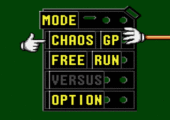
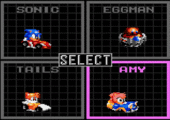
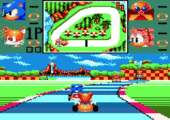
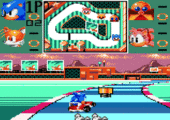
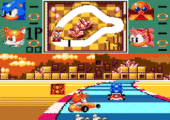
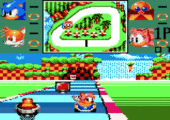
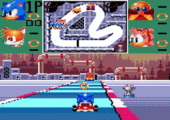
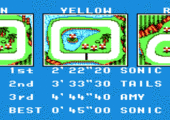
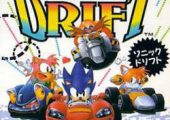
Recent Comments